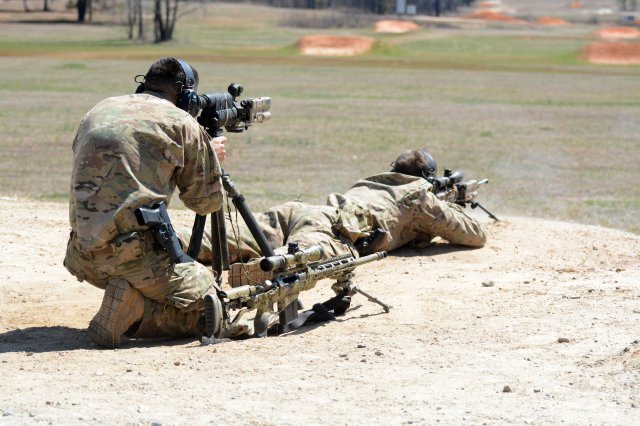Sniper teams from around the globe converged on the Special Forces Sniper Course to put their skills to the test in this year’s United States Army Special Operations Command International Sniper Competition.
Twenty-two teams, including three foreign teams, competed for one year of bragging rights to say they are the best in their business. Each team in the competition was comprised of one shooter and a spotter.
“This competition — the 5th annual competition- has been the most intense competition we have sponsored yet,” said Tim Gozelski, an instructor at the SFSC. “Prior to this, the most events we held was 13, this competition we put in 19 events, going non-stop day and night.”
With this competition, the competitors had a stricter schedule and less time to complete their tasks. Previously, the teams were divided into two groups and briefed on the event. Whichever team that went last had ample time to plan how they were going to engage the targets. To level the playing field, this year cadre developed a round robin style competition, giving teams only five minutes to read the rules of each event and a quick minute for questions before engaging the targets at any specified event.
“Everything was rotational,” said Gozelski. “Competitors cycled through, completed four events, and at the end of the day were able to mingle with other competitors and discuss trade craft and equipment issues.”
Not knowing what to expect, the competitors took on each challenge as it came to them.
This year’s winners from the Army Marksmanship Unit team, who had competed in six other different sniper competitions, found this one to be both physically and mentally challenging.
“The stalk event is a tough challenge,” said Staff Sgt. Daniel J. Horner, with the Army Marksmanship Unit. “You have four or five skilled observers looking for you, and they know generally where you are. It’s a tough game to beat.”
“Coming to the school house, we had no idea what to expect, we came into the events blind and with a very brief description of what you’re going to be doing and then you begin the course of fire,” said Horner. “We knew we would be tested on what is taught here at the SFSC, so we tried to master the basics.”
Teams had to engage targets as close as 50 meters, and as far as 1000 meters, which required teams to communicate effectively.
“If you want to shoot the greatest competition in the sniper world that’s out there then come to this one,” said Sgt. 1st Class Josh Thompson, Special Forces Sniper Course instructor.
Not only were competitors tested on their ability to shoot and engage targets, but also many other tradecraft.
“Sniper competitions in general are a great tool to evaluate training,” said Sgt. 1st Class Andy Roy, Special Forces Sniper Course instructor. “We tested the teams on marksmanship, their dialog, and field craft as well, we tested them on non-specific foreign weapons also.”
One event challenged the competitors to pick up weapons they would normally be less familiar with.
“There were three different foreign weapons systems — the FN FAL rifle, the Heckler and Koch G3 and the M1A rifle,” said Thompson. “There were three perspective ranges, and all weapons were battle sight zeroed to 25 meters.”
Teams had to match preloaded magazines to the weapons and engage the targets, the further the target the more points earned.
“It’s combat application,” said Roy. “We try to run this as much as a combat oriented competition as possible. Its battlefield recovery.”
“The competition is combat oriented on things that have been used on deployment,” said Master Sgt. Jason Brown, SFSC instructor and event coordinator. “Because of this, it tests the competitors on tasks that will help them complete their missions down range.”
Having snipers converge on one area for both competition and camaraderie is a benefit for the individuals and the implementation of new tactics taught to future snipers.
“It brings all the snipers together from all over the world, which gives them a chance to communicate on what they are doing in training to become better snipers,” said Brown. “This helps the SFSC committee because most of the competitors are from the Special Operations Forces Regiments and it allows us to see how well they have been trained by us and how well they are conducting their own training once they have completed ours.”
Stepping up to represent one’s self, unit and country is something to be recognized.
“Anybody who’s willing to go out and compete in the sniper competition, my hat’s off to them,” said Roy. “There are a lot of men who do this job who aren’t willing to go out there to put their professional reputation on the line, their units’ reputations on the line, or countries’ reputations on the line. For those men who are willing to show up here and perhaps get that dose of humility where they can go back and evaluate their training and make needed adjustments, it says a lot about those men. It’s something substantial about the group of men who come here to compete.”










